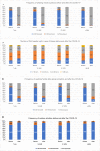Investigation and analysis of children's behavior and outpatient number of respiratory diseases in Shanghai before and after the COVID-19 pandemic
- PMID: 37809910
- PMCID: PMC10558850
- DOI: 10.1016/j.heliyon.2023.e19592
Investigation and analysis of children's behavior and outpatient number of respiratory diseases in Shanghai before and after the COVID-19 pandemic
Abstract
Objective: Alterations in behavioral habits of children were analyzed in Shanghai in the winters prior to and following the COVID-19 pandemic, with the aim of assisting in the prevention of children's respiratory diseases in the post-pandemic era.
Method: This cross-sectional survey was conducted via an offline questionnaire from January 1 to February 28, 2021. The behavioral habits of Shanghainese children in different age groups during the winter of 2019 and 2020 were statistically analyzed using the SPSS 25.0 software. The parameters surveyed and analyzed included the frequency of outdoor activities, self-protection measures (frequency of wearing masks and washing hands after going out), travel history, time to visit since symptom onset, and influenza vaccination status. Lastly, the number of cases of respiratory diseases in the pediatric outpatient department of our hospital was analyzed during the same period.
Result: A total of 1816 questionnaires were investigated and analyzed, and the results revealed that self-protection measures were significantly enhanced in children of all age groups after the COVID-19 pandemic breakout compared with those before the pandemic, whereas the frequency of outdoor activities and traveling were reduced. In the age group over 3 years old, the time to visit since symptom onset was shorter, and the influenza vaccination rate increased following the pandemic. During the same period, the number of cases of children with respiratory diseases in our outpatient department was significantly decreased compared with that prior to the COVID-19 pandemic.
Conclusion: The COVID-19 pandemic has had a significant impact on self-protection measures, outdoor activities, and other children's behaviors in all age groups in Shanghai. These changes in habits were correlated with a lower incidence and transmission of respiratory diseases in children. Overall, this study lays a theoretical basis for the prevention of childhood illnesses in the post-pandemic era.
Keywords: Behavioral habits; COVID-19; Children; Cross-sectional survey.
© 2023 The Authors.
Conflict of interest statement
The authors declare that they have no known competing financial interests or personal relationships that could have appeared to influence the work reported in this paper.
Figures




Similar articles
-
The Influence of the COVID-19 Epidemic on Prevention and Vaccination Behaviors Among Chinese Children and Adolescents: Cross-sectional Online Survey Study.JMIR Public Health Surveill. 2021 May 26;7(5):e26372. doi: 10.2196/26372. JMIR Public Health Surveill. 2021. PMID: 33882450 Free PMC article.
-
The gap between parental knowledge and children practice of myopia control and challenge under COVID-19: a web-based survey in China.Front Public Health. 2024 Jun 12;12:1344188. doi: 10.3389/fpubh.2024.1344188. eCollection 2024. Front Public Health. 2024. PMID: 38932774 Free PMC article.
-
Behavioral changes of preventive activities of influenza among children in satellite cities of a metropolitan area of Tokyo, Japan, by the COVID-19 pandemic.BMC Public Health. 2023 Apr 21;23(1):727. doi: 10.1186/s12889-023-15606-x. BMC Public Health. 2023. PMID: 37085782 Free PMC article.
-
Physical interventions to interrupt or reduce the spread of respiratory viruses.Cochrane Database Syst Rev. 2020 Nov 20;11(11):CD006207. doi: 10.1002/14651858.CD006207.pub5. Cochrane Database Syst Rev. 2020. Update in: Cochrane Database Syst Rev. 2023 Jan 30;1:CD006207. doi: 10.1002/14651858.CD006207.pub6. PMID: 33215698 Free PMC article. Updated.
-
Impact of the COVID-19 pandemic on children's mental health: A systematic review.Front Psychiatry. 2022 Oct 18;13:975936. doi: 10.3389/fpsyt.2022.975936. eCollection 2022. Front Psychiatry. 2022. PMID: 36329921 Free PMC article.
Cited by
-
Risk factors and prescription patterns analysis for macrolide-resistant Mycoplasma pneumoniae pneumonia in children.iScience. 2024 Nov 29;27(12):111503. doi: 10.1016/j.isci.2024.111503. eCollection 2024 Dec 20. iScience. 2024. PMID: 39759004 Free PMC article.
-
Multiplexed detection of respiratory pathogens using a portable device combining a CREM strategy.Chem Sci. 2024 Oct 8;15(44):18411-8. doi: 10.1039/d4sc05226a. Online ahead of print. Chem Sci. 2024. PMID: 39421201 Free PMC article.
References
-
- World Health Organization . 2020. Corona Virus Disease 2019 (COVID-19). Situation Report-51 March 11. [cited 2020 Mar 13]
-
- European Centre for Disease Prevention and Control . 2020. Guidelines for the Use of Non-pharmaceutical Measures to Delay and Mitigate the Impact of 2019-nCoV Feb 10. [cited 2020 Mar 18]
LinkOut - more resources
Full Text Sources

